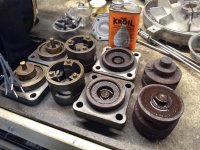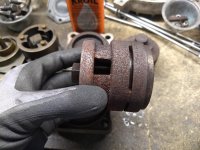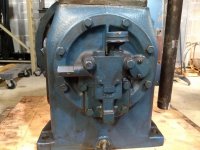Just a Sparky
Hot Rolled
- Joined
- May 2, 2020
- Location
- Minnesota
Just posting to see if anyone else here has any advice to offer when it comes to rebuilding the usual big Quincy pumps. Got mine home and everything seems fine with it except a bum exhaust valve. I only get vacuum and intake noise on one cylinder. The other just sucks backwards through it's exhaust valve.
Any ideas of what to expect? Things to do or avoid while/before I open up the valve covers? Maybe reach out to Quincy for pump-specific documentation?
Pump is Model 244, ROC 11. 1947-48. Old original style unloader units on the intake valves, though I don't foresee needing to disturb them.
Any ideas of what to expect? Things to do or avoid while/before I open up the valve covers? Maybe reach out to Quincy for pump-specific documentation?
Pump is Model 244, ROC 11. 1947-48. Old original style unloader units on the intake valves, though I don't foresee needing to disturb them.







